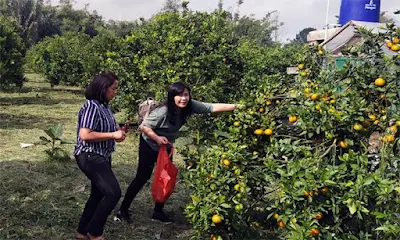Hello, my name is Damayanti Sinaga, but you can call me Butet. In Batak culture, “Butet” is a name often given to female babies, but as I’ve grown, it’s become a part of my identity. Though I’m no longer a baby, the name stuck, especially as many people outside the Batakcommunity call me Butet. Over time, I’ve come to embrace it.
I live in Kampung Ulos Hutaraja Pardamean, a charming village located on the beautiful Samosir Island, which is nestled next to the majestic Lake Toba in the highlands of North Sumatra. Living here, surrounded by natural beauty and rich cultural heritage, fills me with pride. It’s no wonder I’ve become passionate about sharing my home with others.
A Passion for Guiding and Promoting Lake Toba
One of the main reasons I became a tour guide is my deep desire to meet and connect with people from all over the world. Through guiding, I can introduce visitors to the wonders of Lake Toba, which holds a special place in my heart. This volcanic lake is not just a natural wonder; it’s a symbol of my heritage, and I want the world to see its beauty too.
By working as a guide, I can contribute to sustainable tourism, helping to preserve the region’s natural and cultural treasures while supporting the local community. I firmly believe that tourism can be a powerful force for good, and my role as a guide allows me to play an active part in making Lake Toba a top destination for travelers while ensuring it remains vibrant and thriving for generations to come.
A Lifelong Love for Learning and Sharing Knowledge
Aside from guiding, I have a love for reading, research, and continuous learning. I enjoy teaching and often spend my free time sharing knowledge with children in my community. It’s a hobby that brings me immense joy. I believe that learning is a lifelong journey, and I take every opportunity to expand my horizons by learning new languages and making friends from different parts of the world.
My previous experience as an editor at Analisa Newspaper, one of the largest newspapers in North Sumatra, has shaped my communication skills and deepened my understanding of the media and tourism industries. This experience, coupled with my love for storytelling and sharing local culture, has given me the confidence to guide visitors in a way that is both informative and welcoming.
Promoting Sustainable Tourism
As a local, I understand the importance of sustainable tourism and the impact it has on the environment, economy, and society. I want to show tourists the authentic beauty of Lake Toba while ensuring that tourism benefits the local community. Sustainable practices are at the heart of my tours, whether it’s encouraging responsible travel behaviors or supporting local businesses.
Every tour I lead is an opportunity to share the beauty of the land, the history of the Batak people, and the importance of preserving this unique destination. Lake Toba is more than just a place; it’s a story waiting to be told. Through my tours, I hope to help visitors connect with this place in meaningful and lasting ways.
Conclusion: Welcoming the World to Lake Toba
Through my work, I aim to make Lake Toba not just a destination, but an experience that visitors will cherish forever. Whether it’s through a scenic tour of the lake or a cultural walk through my village, I want each traveler to leave with a deeper appreciation of the beauty and culture of North Sumatra.
As I continue to learn, grow, and connect with people from all corners of the globe, I invite you to visit Lake Toba and experience it through my eyes. Let’s create lasting memories together and help make sustainable tourism a priority for everyone.
Thank you for taking the time to get to know me. I look forward to sharing the wonders of Lake Toba with you.
认识达玛扬蒂·西纳加:一位热情的导游,致力于推广多巴湖
大家好,我叫达玛扬蒂·西纳加,但你可以叫我“布特”(Butet)。在巴塔克文化中,“布特”通常是给女婴取的名字。虽然我已不再是婴儿,但这个名字一直伴随着我,尤其是许多非巴塔克社群的人更习惯称呼我“布特”。随着时间的推移,我也接受了这个名字,并将它作为我身份的一部分。
我住在坎榜乌洛斯胡塔拉贾帕尔达曼(Kampung Ulos Hutaraja Pardamean),这是一个风景如画的村庄,位于美丽的苏门答腊北部高地多巴湖旁的萨摩西尔岛。生活在这里,被自然美景和丰富的文化遗产环绕,让我感到无比自豪。难怪我对与他人分享我的家乡充满热情。
热爱导游事业与推广多巴湖
我成为导游的主要原因之一是我非常渴望与来自世界各地的人们见面和交流。通过导游工作,我可以向游客介绍多巴湖的奇迹,这个火山湖在我心中占据特殊的位置。这不仅是一个自然奇观,更是我的文化遗产的象征,我希望世界也能见证它的美丽。
通过从事导游工作,我可以为可持续旅游做出贡献,帮助保护该地区的自然和文化财富,同时支持当地社区。我坚信,旅游业可以成为一种积极的力量,而作为一名导游,我可以积极参与其中,让多巴湖成为旅行者心中的首选目的地,同时确保它的活力和繁荣能够世代传承。
终身热爱学习与分享知识
除了导游工作,我还热爱阅读、研究和持续学习。我喜欢教学,经常利用闲暇时间与社区的孩子们分享知识。这是一个让我感到无比快乐的爱好。我相信学习是一个终身的旅程,我抓住每一个机会,通过学习新语言和结交来自世界各地的朋友来拓展自己的视野。
我之前在北苏门答腊最大的报纸之一《分析报》(Analisa Newspaper)担任编辑的经历,锻炼了我的沟通能力,并加深了我对媒体和旅游行业的理解。这段经历,再加上我对讲故事和分享本地文化的热爱,让我有信心以既具信息性又热情友好的方式引导游客。
推广可持续旅游
作为一名本地人,我深知可持续旅游的重要性及其对环境、经济和社会的影响。我希望向游客展示多巴湖的原始之美,同时确保旅游业惠及当地社区。可持续的实践是我每次导游活动的核心,无论是鼓励负责任的旅行行为,还是支持本地企业。
每一次带团都是一个分享这片土地美景、巴塔克人历史及保护这一独特目的地重要性的机会。多巴湖不仅仅是一个地方,它是一段等待被讲述的故事。通过我的导游工作,我希望帮助游客以深刻和持久的方式与这个地方建立联系。
结语:欢迎世界来到多巴湖
通过我的工作,我的目标是让多巴湖不仅成为一个旅游目的地,更成为一个让游客永生难忘的体验。无论是多巴湖的湖景游,还是穿越我村庄的文化之旅,我希望每一位旅行者都能带着对北苏门答腊美丽和文化的更深理解离开这里。
在我继续学习、成长并与来自世界各地的人们交流的过程中,我诚挚邀请你们来到多巴湖,通过我的视角感受它的魅力。让我们一起创造难忘的回忆,并共同推动可持续旅游成为每个人的优先事项。
感谢你花时间了解我。我期待与您分享多巴湖的奇妙之处!










 Jabu Bolon atau Rumah Batak yang juga menambah daya tarik Tugu Toga Sinaga (foto: Damayanti)[/caption]
Jabu Bolon atau Rumah Batak yang juga menambah daya tarik Tugu Toga Sinaga (foto: Damayanti)[/caption] Suasana di Tugu Toga Sinaga pada Sabtu, 30 November 2024 gerakan penghijauan di Samosir yang dilaksanakan secara simbolis. (Foto ©Damayanti)[/caption]
Suasana di Tugu Toga Sinaga pada Sabtu, 30 November 2024 gerakan penghijauan di Samosir yang dilaksanakan secara simbolis. (Foto ©Damayanti)[/caption]


















